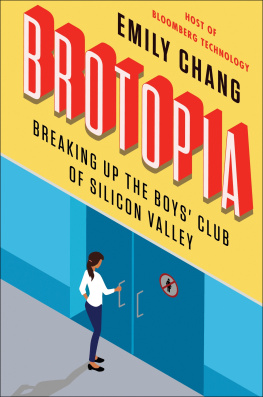Penguin supports copyright. Copyright fuels creativity, encourages diverse voices, promotes free speech, and creates a vibrant culture. Thank you for buying an authorized edition of this book and for complying with copyright laws by not reproducing, scanning, or distributing any part of it in any form without permission. You are supporting writers and allowing Penguin to continue to publish books for every reader.
While the author has made every effort to provide accurate telephone numbers, internet addresses, and other contact information at the time of publication, neither the publisher nor the author assumes any responsibility for errors or for changes that occur after publication. Further, publisher does not have any control over and does not assume any responsibility for author or third-party websites or their content.
INTRODUCTION
NOT JUST A PRETTY FACE: TECHS ORIGINAL SIN
L ENA S DERBERG STARTED OUT as just another Playboy centerfold. The twenty-one-year-old Swedish model told the magazine shed left her native Stockholm for Chicago because shed been swept up in America Fever. In November 1972, Playboy returned her enthusiasm by featuring her, under the name Lenna Sjblom, in its signature spread. If Sderberg had followed the path of her predecessors, her image would have been briefly famous, then relegated to gathering dust under the beds of teenage boys. But one particular photo of Lena Sderberg would not fade into obscurity. Instead, her face would become as famous and recognizable as Mona Lisasnot to most Americans, but to everyone studying computer science for the next half a century.
In engineering circles, some refer to Lena as the first lady of the internet. But others call her the industrys original sin, the first step in Silicon Valleys exclusion of women. Both views stem from an event that took place back in 1973 at a University of Southern California computer lab, where a team of researchers, led by William Pratt, PhD, was trying to turn physical photographs into digital bits. The work would pave the way for the development of the JPEG, a compression scheme that allows large image files to be efficiently transferred between devices. But the JPEG was far into the future. In 1973, researchers needed to test their algorithms on suitable photospictures full of detail and texture. And their search for the ideal test photo led them to Lena.
Until now, the role of Dr. William Pratt in the choice of Lenas photo has been unknown. I tracked Pratt down thanks to a passing lead on an old message board. He had left USC to take a job at Sun Microsystems and was working pro bono at Stanford Hospital, scouring MRIs and CT scans.
In a telephone interview, Pratt explained how he and his team had just received a large grant from ARPA (today known as DARPA), a Department of Defense agency that would lay the groundwork for the invention of the internet. The grad students were gathering photos that would provide good test subjects for their algorithms. Conveniently, a student had recently brought in a copy of the previous Novembers Playboy. I think they were enjoying the magazine, and it just happened to be there, Pratt told me. When I asked if he or any of the grad students had been concerned that using Playboy photos for their research might offend anyone, he said that issue simply didnt come up.
Pratts team flipped through the glossy magazine looking for usable images. I said, There are some pretty nice-looking pictures in there, he remembered, and the grad students picked the one that was in the centerfold. The full three-page spread of Lena, wearing boots, a boa, and a floppy, feathered hat, shows her bare backside and one exposed breast. But because the 1970s-era scanners they were experimenting with were much smaller than current models, the chosen photo was cropped into a relatively chaste square in which Lena looks suggestively over her bare shoulder.
From a technical standpoint, Pratt told me, Lenas photo was ideal because all the different colors and textures made it a challenge to process. She is wearing a hat with a big feather on it with lots of high-frequency detail that is difficult to code, he said.
Over the next several years, Pratts team developed a whole library of digital images not from Playboy. The original data set included photos of a brightly colored mandrill, a rainbow of bell peppers, and several photos of other fully clothed women simply titled Girl. Scanners were relatively rare at that time, so they made some of this library available for other imaging scientists to test their algorithms. One of the things you want to do is compare your work to others in the field, Pratt said, and in order to do that, you have to start with the same original. Each of us tried to code algorithms better than our neighbors.
All of these photos, including Lenas, are still available to download for free from the USC website, but for decades Lenas has been by far the most popular. Her image has been displayed in countless projects, slide-show presentations, journals, books, and conference papers. She has served as a test subject for a myriad of editing techniques, including color correction and auto-focus. New research featuring her picture is published monthly.
Playboy, notoriously vigilant about copyright infringement, decided to let the burgeoning image-processing industry make Lena its go-to. Company executives saw the photos ubiquity as free publicity rather than the precursor of an internet sex industry that would profoundly disrupt the soft-porn magazine business. In a 2013 article, Playboy highlighted an industry newsletters assertion that Lena was, to early computer scientists, what Rita Hayworth was to World War II soldiers: the top pinup girl of the era.
For fifty years, this womans face and bare shoulder have served as a benchmark for image-processing quality, from the teams working on Apples iPhone camera to Google Images. Engineers joke that if you want your algorithm to perform well, it better perform well on Lena. Some know her photo so intimately that with little more than a glance they can easily evaluate any image algorithm run on her.
MEETING LENA
Deanna Needell remembers the moment when she first saw Lena in a textbook during one of her computer science classes at the University of Nevada, Reno. Some of the boys were giggling and I remember thinking, What are they giggling about? And they were looking at her picture, Needell recalls. Shortly afterward, she learned that the smiling woman was in fact fully nude. It made me realize, Oh, I am the only woman. I am different. It made gender an issue for me where it wasnt before. Another female engineer told me that, as a young computer science student, she thought Lena was just a pretty face, until she saw the full centerfold taped onto the door of a male classmates dorm room.
Needell, who went on to become valedictorian of her college class and a mathematics professor at UCLA, strongly believes Lenas photo is one reason women have been left behind in technology. In 2013, she took a stand that has evolved into somewhat of a campaign to rid the industry of the image for good. Needells humorous starting point was this: in an otherwise serious paper about a particular image-processing technique, she and her co-author Rachel Ward tested an image of the Italian male model Fabio. We contacted Fabios agent... and apparently Fabio was thrilled, Needell recalls. She chose an image that, like Lenas, featured a variety of detail and textures, from Fabios long blond hair to bricks in the background. The paper was published in the






